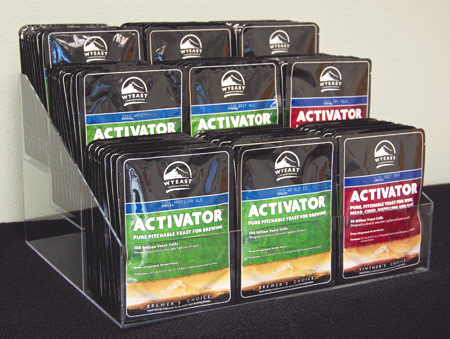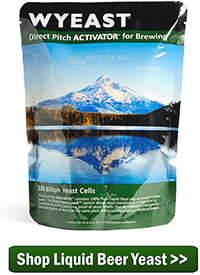 In part 1 of this series, we discussed several of the choices that come up when choosing the right yeast strain for your homebrew: dry yeast vs. liquid yeast, ales strains vs. lagers strains, flavor, attenuation, and flocculation.
In part 1 of this series, we discussed several of the choices that come up when choosing the right yeast strain for your homebrew: dry yeast vs. liquid yeast, ales strains vs. lagers strains, flavor, attenuation, and flocculation.
In this blog post, I’ll introduce several of the most popular yeast strains used by homebrewers.
Homebrewing Yeast Style Guide
This is by no means a comprehensive list of every yeast you could use to brew your own beer, simply a guide for some of the most commonly brewed beer styles. Click here to browse our complete selection of homebrewing yeast strains.
German Ale Yeast Options
- Wyeast 1007: German Ale Yeast – A very versatile yeast strain, traditionally used for German Altbier, but often used for American ales; ferments clean with low ester production and finishes dry; requires fairly low fermentation temperature for neutral flavor.
- Wyeast 3056: Bavarian Wheat Blend – Used for brewing German weizen, a wheat beer characterized by yeast-derived banana and clove flavors; this is a relatively neutral strain.
- Wyeast 3068: Weihenstephan Weizen – An alternative to 3056 (above), this strain of weizen yeast is sourced from the Weihenstephan brewery in Germany, which claims to be the oldest brewery in the world. It is a vigorous fermenter producing characteristic banana/clove flavors, which can be controlled by adjustments in fermentation temperature and wort density (high – more banana, low – more clove). A lower pitch rate will enhance banana character.
- Danstar Munich – A dry yeast for brewing Bavarian weizen.
- Wyeast 2565: Kolsch – The preferred yeast for Kolschbier, ferments at cooler temperatures than most top-fermenting ale yeasts, enhancing smooth, lager-like character with a hint of apple. Can also be used to ferment lager styles when temperature control is a challenge.
German Lagers Yeast Options
- Fermentis Saflager S-23 – Dry yeast, deal for Berliner pilsners; also suitable for American lagers.
- Fermentis Saflager 34/70 – Dry yeast, sourced from the Weihenstephan brewery in Germany, produces a malt-forward beer with plenty of body.
- Wyeast 2206: Bavarian Lager – Suitable for malty, German lagers, especially Munich-style beers and Oktoberfest.
Belgian Ales Yeast Options
- Wyeast 1388: Belgian Strong Ale – A high-attenuating, alcohol-tolerant, liquid yeast strain recommended for fermenting golden strong ales. Yields a dry beer with a mild tartness.
- Wyeast 1762: Belgian Abbey II – Temperature- and alcohol- tolerant strain derived from the Trappist brewery Rochefort; produces some dried fruit esters at higher temperatures.
- Wyeast 3787: Trappist High Gravity – Wide temperature range and high alcohol tolerance make this a good strain for abbey-style dubbels, tripels, and quads; great fit for a Westmalle Tripel Clone.
- Mangrove Jack’s M27: Belgian Ale – A dry Belgian ale yeast, tolerant of warmer fermentation temperatures and high alcohol. Use it for saisons, tripels, and quadrupels.
- Wyeast 3942: Belgian Wheat – Produces subtle apple and bubblegum esters, highly recommended for Belgian witbier.
- Wyeast 3278: Belgian Lambic Blend – A blend of yeast and bacteria cultures for the production of Belgian sour beer. For advanced brewers.
American/English/Irish Ales Yeast Options
I lump these strains together because there is a lot of crossover between English and American styles. Indeed, many of the “American” yeast strains we know and love simply migrated from Europe. Where applicable, I’ve provided some more specific guidelines for some of the more distinctive beer styles, like Irish Stout.
- Wyeast 1056: American Ale – Extremely popular style for American pale ales and IPAs, originally sourced from Sierra Nevada Brewery; tends to be very neutral, but may produce citrus notes at the low end of the fermentation temperature range.
- Fermentis Safale US-05 – Same strain as Wyeast 1056, above, but in dry form; sometimes called the “Chico” strain; acceptable for a wide range of American style ales.
- Wyeast 1272: American Ale II – An alternative American yeast strain; accentuates the citrus notes of hoppy American pale ales and IPAs.
- Wyeast 1084: Irish Ale – the classic strain for Irish stouts, this yeast has a slightly lower attenuation, making it ideal for full-bodied beers.
- Danstar Nottingham – A versatile, fast-working, high-flocculating, high-attenuating dry ale yeast; many homebrewers’ go-to strain for American and English ales; tolerance at lower temperatures allows it to be used for lagers.
- Fermentis Safale S-04 – Dry yeast; classic English ale strain with neutral flavor characteristics; works quickly and flocculates well.
- Wyeast 1099: Whitbread – Liquid yeast version of Safale S-04 (above); ideal for a range of British ales.
Cider Yeast Options
- Mangrove Jack’s M02 – Dry yeast for fermenting apple cider; high attenuation and flocculation. Imparts fruity esters to give cider depth of flavor and enhance fruit character.
- Wyeast 3766: Cider – Liquid strain of cider yeast for fermenting a crisp, dry cider. Also works well for pear and peach wine.
These are some of the most popular strains of homebrewing yeast – what are some of your favorites?
———————————–
David Ackley is a beer writer, brewer, and self-described “craft beer crusader.” He holds a General Certificate in Brewing from the Institute of Brewing and Distilling and is founder and editor of the Local Beer Blog.
